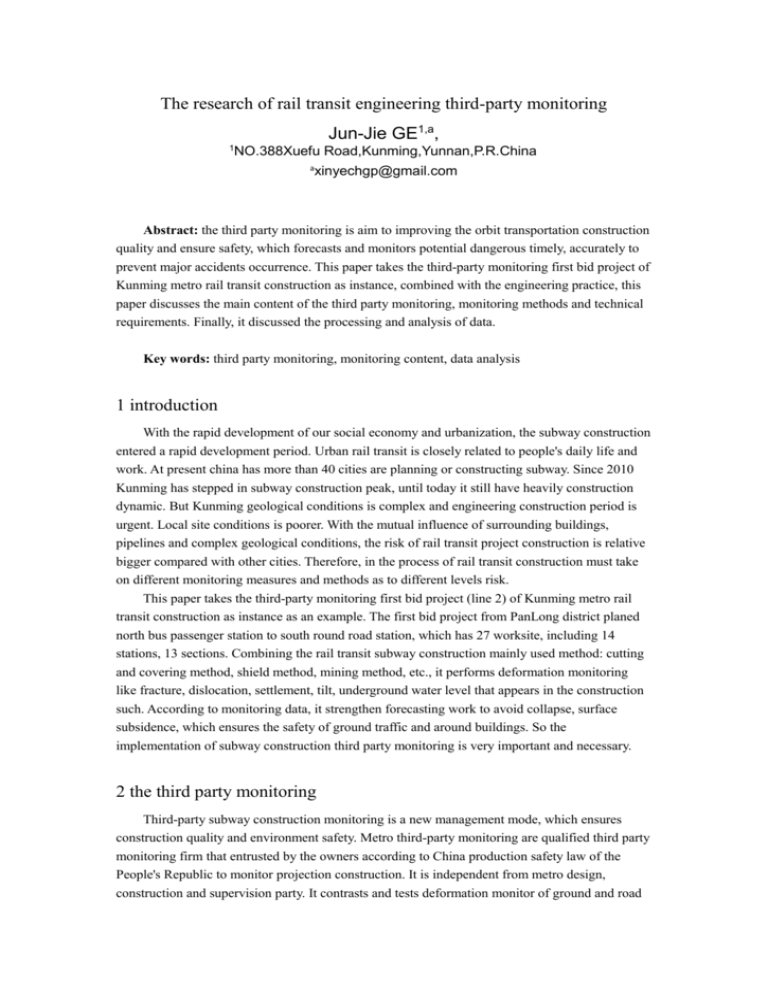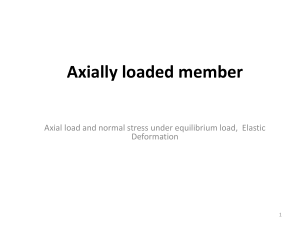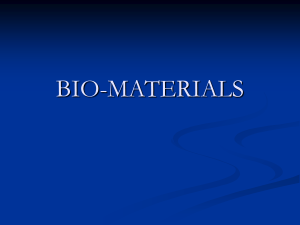Paper
advertisement

The research of rail transit engineering third-party monitoring Jun-Jie GE1,a, 1 NO.388Xuefu Road,Kunming,Yunnan,P.R.China axinyechgp@gmail.com Abstract: the third party monitoring is aim to improving the orbit transportation construction quality and ensure safety, which forecasts and monitors potential dangerous timely, accurately to prevent major accidents occurrence. This paper takes the third-party monitoring first bid project of Kunming metro rail transit construction as instance, combined with the engineering practice, this paper discusses the main content of the third party monitoring, monitoring methods and technical requirements. Finally, it discussed the processing and analysis of data. Key words: third party monitoring, monitoring content, data analysis 1 introduction With the rapid development of our social economy and urbanization, the subway construction entered a rapid development period. Urban rail transit is closely related to people's daily life and work. At present china has more than 40 cities are planning or constructing subway. Since 2010 Kunming has stepped in subway construction peak, until today it still have heavily construction dynamic. But Kunming geological conditions is complex and engineering construction period is urgent. Local site conditions is poorer. With the mutual influence of surrounding buildings, pipelines and complex geological conditions, the risk of rail transit project construction is relative bigger compared with other cities. Therefore, in the process of rail transit construction must take on different monitoring measures and methods as to different levels risk. This paper takes the third-party monitoring first bid project (line 2) of Kunming metro rail transit construction as instance as an example. The first bid project from PanLong district planed north bus passenger station to south round road station, which has 27 worksite, including 14 stations, 13 sections. Combining the rail transit subway construction mainly used method: cutting and covering method, shield method, mining method, etc., it performs deformation monitoring like fracture, dislocation, settlement, tilt, underground water level that appears in the construction such. According to monitoring data, it strengthen forecasting work to avoid collapse, surface subsidence, which ensures the safety of ground traffic and around buildings. So the implementation of subway construction third party monitoring is very important and necessary. 2 the third party monitoring Third-party subway construction monitoring is a new management mode, which ensures construction quality and environment safety. Metro third-party monitoring are qualified third party monitoring firm that entrusted by the owners according to China production safety law of the People's Republic to monitor projection construction. It is independent from metro design, construction and supervision party. It contrasts and tests deformation monitor of ground and road subsidence, building and underground pipeline that along the subway construction. It use the mathematical statistics modern theory to deal with monitoring data, trough analysis and forecast result to prevent and avoid the tunnel collapse, surrounding buildings damage. So it prevent tremendous accidents effectively and ensure subway construction production safety. Monitoring scope: open cutting foundation trench, mining method tunnel construction, shield method tunnel construction, and objects within tunnel 2.0 H surrounding scope and open cutting foundation trench surface and supporting system, mining method tunnel excavation face five times the hole diameter supporting structure, shield method five times the hole diameter construction scope of the segment structure. 2.1 subsidence monitoring Subsidence monitoring items include: pile top subsidence; surface subsidence; building foundation settlement; underground pipeline settlement; vault sink; supporting pillar settlement; relative and absolute sink that ground fissure corresponded. 2.1.1 Layout principle of measuring point The project settlement deformation monitoring control network (or points), were established with Kunming first period rail transit engineering construction elevation system, which started with suitable control network second-class leveling point for subway construction. Control points is composed by datum point and work basis points. According to the distribution condition of station, building at interval for monitoring, bridge and, road surface, Control net was setting to local independent network, using observation point, it sets into a closed loop network, connecting network or connecting traverse form. It uses artificial excavation or drill a hole to produce ground reference point and work basis points. As to different monitoring objects using different way to produce measure point. Framework, brick structure object uses borehole embedded measuring point, Steel structure adopts welded measuring point, special decorate object uses concealment measuring point. Subsidence monitoring measuring point should avoid drainage pipe, window sill lines, electric switch and obstacles. Positioned leveling rod should leave wall surface and ground some distance and 0.2 ~ 0.5 m higher than floor. 2.1.2 Subsidence monitoring methods and technical requirements Adopting geometric leveling method conducts leveling network observation. It uses Trimble DINI12 electronic level owned record program to record field observation data file. According to engineering measurement specification GB50026-2007 third-class vertical displacement monitoring network technical requirements, the main technical indicators and requirements are shown in table 1. Table 1 Monitoring point main technical indicators and the requirements serial number 1 indicator tolerance Monitoring point and adjacent datum point 1.0mm elevation difference in error mean square error 2 3 4 Each station elevation difference mean 0.30mm square error Roundtrip mutual difference and loop closure error Measured station elevation difference ±0.6 n mm(n is station number) ±0.8 n mm(n is station number) 2.2 Slant monitoring 2.2.1 Layout principles of measuring-point As to ordinary low-rise building, it can calculation based tilt according to the settlement difference of observation data. The project tilt monitoring object is mainly refers to main body of tall building tilt monitoring. It can use physical body tilt monitor Pitch point method, horizontal Angle measurement method, the forward intersection method, laser scanner method, digital photogrammetry observation method, and special tilt sensor test method to conduct High-rise building tilt monitoring. Considering Kunming subway engineering environment conditions, monitoring precision requirements, engineering cost comprehensively. Main body of tall building project adopts forward intersection method to monitor tilt. Measuring point should be fixed in slant building top and bottom., the principle of measuring-point: (1) observation points were fixed in the place where can reflect the deformation part accurately, and, in parallel to the main body of building vertical axis top and bottom location;(2) top and bottom measuring point should be good visibility with control point, no obstructions and refraction. 2.2.2The slant monitoring methods and technical requirements Oblique observation adopts forward intersection method, using a Leica TCA1800 total station, PDA to record the field observation data file. It follows engineering measurement GB50026-2007 second-class horizontal displacement monitoring network technical requirements to conduct forward intersection measurement of building oblique observation. The main technical requirements are shown in table 2. Table 2 main observation technical indicators and requirements serial number item Indicators or tolerance 1 Horizontal Angle observation number 6 2 mean square error of angle 1.0 秒 3 side relative error ≤1/100000 4 measurement number of each side roundtrip 4 times 2.3 horizontal displacement monitoring Horizontal displacement monitoring items include: embosom pile top horizontal displacement, building oblique, and relative and absolute horizontal displacement of ground fissure. 2.3.1 Layout principles of measuring-point It adopts traverse network to monitor embosom pile top horizontal displacement. It uses polar coordinate method to perform measuring point monitoring. It uses Kunming rail transit first period engineering construction plane control system to establish control points. It. adopt adhesion or closure traverse, starting and closed on the subway precision transverse. It distributes control points according to the embosom field condition and foundation ditch position reasonably. Generally it has no less than three points in each foundation ditch, it consist monitoring network with the observation point. According to the third party monitoring design drawings it posits point on the top of foundation ditch embosom wall around. Layout principles: (1) Measuring point should be designed in foundation ditch ring beam and embosom wall or the top of the underground continuous wall where is relatively fixed place. The place is easy to set and not easy to damage. It can reflect lateral deformation of foundation embosom structure top pile (wall).(2) it fixes points around the foundation ditch wall, pile top ,decorating1 point every 20 m;(3) measuring point set centering sign . 2.3.2 Horizontal displacement monitoring method and technical requirements It adopts traverse network to monitor embosom pile top horizontal displacement. It uses polar coordinate method to perform measuring point monitoring. It uses Leica TCA1800 total station to monitor. It follows engineering measurement GB50026-2007 second-class horizontal displacement monitoring network technical requirements to conduct control network setting and the monitoring point observation. The main technical requirements are shown in table 3. Table 3 main technical indicators and requirements serial number item Indicators or tolerance 1 Horizontal Angle observation number 6 2 mean square error of angle 1.0 秒 3 side relative error ≤1/100000 4 measurement number of each side roundtrip 4 times According to the actual work experience, as to reference point observation, traverse method is easy to operate. Using high precision measuring instruments and according to the corresponding operation technical specification, it is easy to achieve the monitoring accuracy. 2.4the underground water level monitoring 2.4.1 Layout principles of measuring-point It should according to the hydrological data to bury water level monitoring pipe. It should posit close to the foundation ditch or tunnel outside that parallel to the foundation ditch or tunnel .It is in the same fracture surface of road and the surface subsidence pile (wall) top, strut axial where the water content and water permeability is strong. In this project, it generally posits 3 ~ 5 monitoring hole around station foundation ditch the, complicated geological conditions interval posits 3 ~ 5 monitoring holes. 2.4.2 The underground water level monitoring method and technical requirements Near the monitoring foundation ditch or tunnel, it uses geological drilling rig to drill into required depth (usually below perennial water level 10 m), casing filtering plastic into the hole, pipe diameter is about 90 mm. it fills clean sand between casing and hole wall, and rinses, at the bore hole bottom to prevent mud plugging. Tube should above the ground about 20 cm, adding a lid don't let the rain in. some brick structure is built around the pipe to prevent damage. Underground water level monitoring can use ruler to gauge, the principle of steel rule water level gauge is putting water level indicator into buried pipes slowly, once the head of water level indicator contacts the water, it start to make sounds, then readings measuring ruler top position value .Every time readings position should be consistent to corresponding pipe top, and fixed the personnel to read. According to the elevation of pipe top and the ground elevation difference, it can calculate height and depth of underground water level. 3 the data processing and analysis The main analysis content and rail transit engineering deformation monitoring object is ground, road, building subsidence and underground pipeline spatial characteristics and dynamic changes, which along the subway. This method selects some feature points to periodical repeated observation. Through the data processing, it acquires data function relation that reflects the change rule by monitoring group subsidence, horizontal displacement variation with time. It uses this data function relation to forecast the next phase monitoring data, possibility of monitoring point maximum displacement or stress value, which predicts monitor objects safety condition to determine the engineering measures. Observation adjustment calculation requirements: (1) The stability of the datum point be calculated and independent closure error and connecting traverse error must satisfy the precision requirement, which ensure the initial data accuracy;(2) before the adjustment ,it tests the stability of control points and compares the Angle and distance of the periods adjacent control points, which ensures the data reliability; (3) Using huaxing survey control net adjustment software, it checks observation data accuracy and reliability before the adjustment. If checked data is qualified then it uses rigorous method to calculate (4) adjustment data should be accurate to 0.1 mm. Through periodic deformation observation point elevation value, it calculates periods phases subsidence, deformation rate, cumulative settlement data, etc. The results are shown in table 4, table 5. The first phase project of kunming rail transit Device Name:Timble data:2010.09.20~2010.09.26 last term accumulat ive measureme variation measureme initial nt value nt num value(mm) position (mm) 9.19 A~BInterval Ming dig period DiNi0.3electronic level ground surface settlement Device number:732144 currentaccumulated variation(mm) 9.20 9.21 9.22 -16.6 -9.5 9.23 9.24 9.25 -19.2 -10.8 9.26 The third party monitoring report check data:2010.07.02 report num:07-01-01 current accumulat current deformati control value initial ed displacem on observati conclusio displacem ent rate(mm/d on time n ent change(mm ) change(mm ) accumulat rate(mm/d ) ed ) value(mm) -2.6 -19.2 -0.65 -25.0 10.07.24 warning -1.3 -10.8 -0.33 -25.0 10.07.24 normal D1-2 D1-3 0.0 0.0 D1-4 0.0 -3.2 -4.2 -1.0 -4.2 -0.11 -25.0 10.07.24 normal D1-6 D1-7 D2-2 D2-3 D2-4 D2-6 D2-7 0.0 0.0 0.0 0.0 0.0 0.0 0.0 -11.6 -11.2 -17.4 -12.4 -8.7 -4.2 -4.9 -11.3 -11.2 -19.7 -14.4 0.3 0.0 -2.3 -2.0 0.07 0.00 -0.58 -0.50 -4.7 -5.5 -0.5 -0.6 -11.3 -11.2 -19.7 -14.4 -8.7 -4.7 -5.5 -25.0 -25.0 -25.0 -25.0 -25.0 -25.0 -25.0 10.07.24 10.07.24 10.07.24 10.07.24 10.07.29 10.07.24 10.07.24 normal normal warning normal resisted normal normal D3-1 0.0 -2.5 -25.0 10.07.24 normal D3-2 D3-3 D3-4 D3-6 0.0 0.0 0.0 0.0 -7.2 -8.4 -7.6 -7.6 -9.0 -10.2 -8.8 -8.2 -1.8 -1.8 -1.2 -0.6 -25.0 -25.0 -25.0 -25.0 10.07.29 10.07.24 10.07.24 10.07.24 normal normal normal normal ±2.0 -0.13 -0.15 -2.5 -9.0 -10.2 -8.8 -8.2 -0.45 -0.45 -0.30 -0.15 备注 last time9.14 last time 9.16 Table 5 the maximum value of monitoring data statistics This period The maximum The measure period The average monitoring maximum accumulative accumulative monitoring point deformation deformation program deformation deformation deformation state number rate (mm/d) rate (mm/d) (mm) (mm) values (mm) surface subsidence D1-2 D2-2 -2.6 -19.7 -0.65 -25.0 ±2.0 normal -0.58 -25.0 ±2.0 warning Note: positive settlement deformation value is ridgy and negative is sinking; positive wall deformation offsets into foundation ditch, negative is offsetting outside to foundation ditch, Underground water level rising is positive and lowing is negative. On the basis of monitoring data and statistics, it draws a graph (see figure 1) for predicting and analyzing the stability of observation point. (1)Observation point stability analysis uses stable datum point as reference point to calculate adjustment results; (2) Through comparing the maximum deformation and maximum measurement error (twice mean square error), it analyzes two phase observation point changes. When maximum deformation is less than maximum measurement error, that means two periods observation points haven’t significant change or change ;( 3) As to multiphase deformation observation results, when adjacent period deformation is small, but the variation trend is obvious, it shall be deemed to have a change. If found abnormal monitoring stations, it conducts warning judgment analysis. (1) Comparing the phase distortion rate and the accumulative deformation value. If phase deformation rate or accumulative deformation value less than warning value, it is normal state; If phase deformation rate or accumulative deformation value one of them is bigger than warning value but less than the control values ,it is warning state. If phase deformation rate or accumulative deformation value one of them is bigger than control values, it is control state. (2) if data is warning state, it performs comprehensive judgment according to inspect information, construction schedule, construction measures condition, supporting palisade structure stability, surrounding environment condition stability (3) confirmed analysis that abnormal situation, it should notify the relevant parties to take measures promptly. surface settlement 0 (mm) Cumulative settlement typical curve of -10 -20 7/24 8/3 8/13 8/23 9/2 9/12 D1-2 D2-2 D2-3 D2-4 D2-6 D3-3 D3-6 D4-3 D4-6 D5-2 D5-4 9/22 data Table 1 typical curve of surface settlement 4. Conclusion Due to the different geological condition between Kunming Beijing, Shanghai, Shenzhen and other places, it is more complex. So it uses different monitoring methods to conduct third party monitoring of the first phase project of Kunming rail transit project bid. It monitors pile (wall) of the foundation ditch deformation, pile (wall) top horizontal displacement, ground subsidence, building inclined.it can be monitor subway construction surroundings timely. In the construction critical period or abnormal situation, it adds frequencies appropriately. At abnormal situations, it adjusts and strengthens monitoring plan dynamically. Monitoring solution improves engineering quality and safety of subway construction, which ensures the subway construction smoothly. Therefore, it plays a guiding role and significance to research and summary third party monitoring rail transit project technology methods and data processing and analysis. References [1] Dengli. The third party monitoring application research in xi 'an subway construction. Science and technology in western China,2013(1) :1-3 [2] GB 50026-2007. Engineering surveying specification [S]. [3] JGJ/T 8-2007. Building deformation surveying specification [S]. [4] JGJ120-99. Construction of foundation ditch supporting technology regulation [S].







